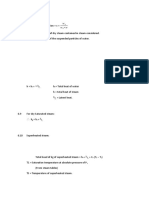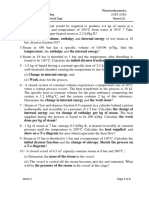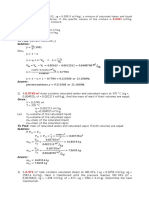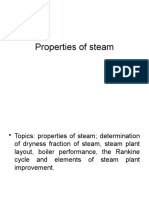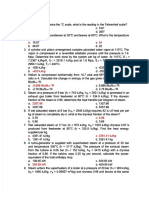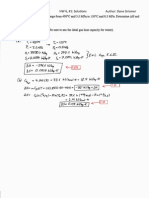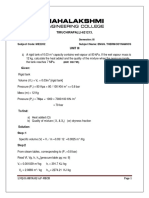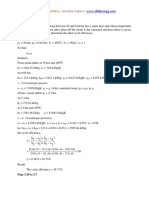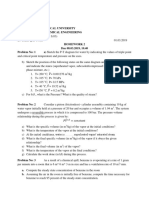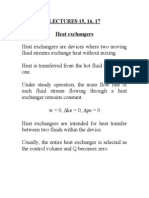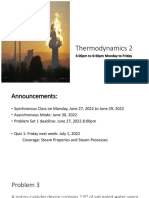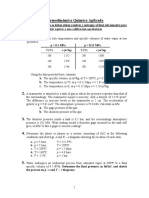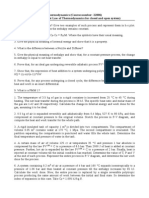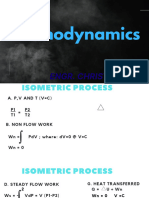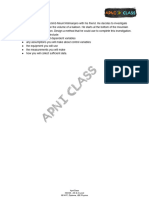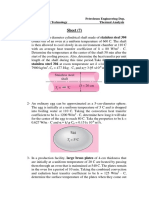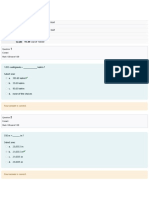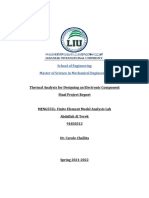STEAM TUTORIAL
1. Steam at 300kPa has a dryness fraction of 0, 8. Find:-
1.1. The specific volume. [0, 48m3/kg]
1.2. The specific enthalpy. [2291, 4kJ/kg]
1.3. The specific internal energy of steam. [2147, 4kJ/kg]
2. A cylinder having a volume of 0, 05m3 contains steam 0, 757 dry at 1000kPa.
Calculate:-
2.1. The mass of steam in the cylinder. [0, 34kg]
2.2. Its enthalpy. [2287, 5kJ/kg]
2.3. The internal energy. [2140, 51kJ/kg]
3. For 1kg dry saturated steam at 200kPa is heated at constant pressure until it reaches
a volume of 1, 285m3/kg. Determine:-
3.1. The work done. [79, 92kJ/kg]
3.2. The heat flow. [347kJ/kg]
4. Steam flowing at the rate of 2, 27kg/s at a pressure of 800kPa and unknown dryness
fraction is throttled to a pressure of 100kPa and a temperature of 127 0C. If the
velocity of the steam in the pipes is 22m/s; calculate the diameter of the pipes on
both sides of the throttling device. [0, 175m; 48, 68mm]
5. 0, 2kg of steam with an initial dryness fraction of 0, 7 is heated at constant pressure
of 700kPa until the volume is doubled. Draw a P-V diagram reflecting all details as
well as the area which represents the work done during the process and determine:-
5.1. The final temperature of the steam. [3200C]
5.2. The heat flow during the process. [191, 3kJ]
6. 0, 1kg of steam at 1400kPa is contained in a rigid vessel of capacity 0, 0189m 3.
Determine:-
6.1. The temperature of the steam. [3200C]
6.2. If the vessel is cooled; at what temperature will the steam be just dry
saturated?
6.3. If cooling is continued until the pressure in the vessel is 200kPa; calculate the
final dryness fraction of the steam. [0, 21]
7. A piston-cylinder device contains 0, 2kg of water initially at 800kPa and with a
volume of 0, 08m3. Now; 75kJ of heat is transferred to the water while its pressure is
kept constant. Determine:-
7.1. The initial temperature. [4300C]
7.2. The final temperature. [6000C]
7.3. The work done. [17,28kJ]
If the piston is now pulled back and the steam is allowed to expand isentropically to
a pressure of 4kPa. Determine:-
7.4. The condition of the steam. [0, 958]
7.5. The work done. [194, 65kJ]
Page 1 of 5
� 7.6. Draw the complete process on the P-v and T-s diagrams reflecting all the
details. Also indicate the areas which represents the work done and heat flow for
both processes.
8. During the operation of a steam engine, the piston was pulled back and the steam
pressure dropped from 3000kPa to 1000kPa. The initial temperature was 250 0C and
the polytropic index of expansion was 1, 35. Determine:-
8.1. The quality of the steam after expansion. [0, 82]
8.2. The work done during the expansion process. [148 kJ/kg]
8.3. The heat flow to or from the system. [- 243, 72 kJ/kg]
8.4. Draw a P-v and T-s diagrams. Use entropy values to verify the curve direction
on the T-s diagram.
9. To reduce electricity consumption, a steam cooker is used in a kitchen to cook food.
The maximum operating pressure of the cooker is Pgauge = 80kPa and the house is
situated at the coast (Patm = 100kPa). The cooker is filled with 2kg of water at a
temperature of 150C and releases steam through a blow-off valve once the operating
pressure is reached. Neglect the work done to open the valve and the amount of
steam blown-off. Determine:-
9.1. The heat required to form wet steam with a dryness fraction of 0, 7 from
saturated liquid. [1326, 6kJ]
9.2. The change in internal energy during the process. [1221, 05kJ]
9.3. Plot the process on both the P-v and T-s diagrams.
10. A kettle has a 2kW element and has a capacity of 1, 7litres. If you want to make one
cup of coffee (cup size = 500ml); determine:-
10.1. The time required to boil enough water for one cup, if the water temperature
is 150C. [88, 6 seconds]
10.2. The amount of energy (time) required to boil a full kettle of water if the water
temperature is 150C. [301, 1 seconds ≈ 5 minutes]
10.3. Why is it not wise to boil more water than what is required?
11. Steam cookers are used for preparing large amounts of food. These devices have
steam jackets through which steam travels while heating up the inner shell of the
cooker. Steam enters the cooker at 2000kPa and with a dryness fraction of 0, 9. At
exit from the cooker the dryness fraction has dropped to 0, 5 and the pressure is
1800kPa. Neglecting the difference in inlet and exit velocity; determine the specific
energy given to the inner shell to cook the food. Neglect losses from the outer shell
to the atmosphere. [-768, 1kJ/kg]
12. Steam expands behind a piston adiabatically from a pressure of 5000kPa to a
pressure of 1000kPa. At the end of expansion the steam has a dryness fraction of 0,
9. Determine:-
12.1. The temperature of the steam at the beginning of the process. [288, 850C]
12.2. The work done during the expansion. (Use interpolation only).[267, 97kJ/kg]
The steam is now heated in the cylinder while the piston is retracted keeping
pressure constant until the specific volume reached a value of 0, 3065m 3/kg. Determine:-
12.3. The work done during the heating process. [131, 63kJ/kg]
Page 2 of 5
� 12.4. The heat supplied to the steam. [699kJ/kg]
12.5. Draw the P-v and T-s diagrams of the complete process showing all the
details.
13. Steam at 980kPa and dryness of 0, 95 is available. Find the final dryness fraction of
the steam in each of the following operations:-
13.1. 168kJ of heat is removed per kilogram of steam at constant pressure.[0, 867]
13.2. It is cooled at constant volume until its temperature is 148, 80C. [0, 38]
13.3. The steam expands isentropically in a cylinder to a pressure of 400kPa. [0,
899]
14. Three kilograms of steam is used to maintain the correct temperature of a plastic
during an injection moulding process. The steam has a pressure of 2000kPa and a
temperature of 3000C. At the end of the moulding process the steam has a pressure
of 2000kPa, a temperature of 212, 40C and the volume is 0, 039816m3/kg. Determine
using the tables:-
14.1. The condition of the steam at the start of the moulding process.
[superheated]
14.2. The specific volume of the steam at the start of the process. [0, 1245m3/kg]
14.3. The condition of the “steam”at the end of the moulding process. [0, 4]
14.4. The energy lost by the steam during the process. [- 4084, 2kJ]
The piston in the piston-cylinder device with the steam at 2000kPa, 212, 4 0C and a
volume of 0, 039816m3/kg is then moved back until the pressure drops to 1000kPa
and the volume is 0, 06783m3/kg. Determine:-
14.5. The index ‘n’ of expansion. [1, 3]
14.6. The work done during the expansion process. [39, 34kJ/kg]
14.7. The condition of steam after expansion process. [0, 35]
14.8. Draw a neat P-v and T- s diagrams of expansion process which took place
inside the piston-cylinder device. Hence, prove your T-s diagram’s direction with
entropy values. [3, 69kJ/kg K]
15. Steam at 3000kPa and with an enthalpy of 2995kJ/kg expands adiabatically to a
pressure of 200kPa. The steam is then heated at constant pressure until it is just dry.
Draw both processes on a T- s and P- v diagrams. Then calculate for one kg of steam
(making use of steam tables only):-
15.1. The condition of the steam after expansion. [0, 895]
15.2. The work done during the expansion process. [424, 58kJ/kg]
15.3. The heat supplied to the steam. [220, 5kJ/kg]
15.4. The overall change in specific volume. [0, 8044m3/kg]
16. Steam is at a temperature of 2500C and with a specific volume of 0, 2328m3/kg. The
steam is now allowed to cool down until the specific volume becomes 0, 13601m 3/kg
while the pressure remains constant. Determine:-
16.1. The pressure of the steam. [1000kPa]
16.2. The condition of the steam after being cooled. [0, 7]
16.3. The work done during the cooling process. [-96, 79kJ/kg]
16.4. The heat lost during the cooling process. [771, 2kJ/kg]
16.5. Draw the fully detailed P- v and T- s diagrams for this process.
Page 3 of 5
� The steam is compressed adiabatically from a pressure of 800kPa and a dryness
fraction of 0, 5 to a pressure of 2000kPa and a temperature of 3000C. Determine the
specific work done on the steam. [1125, 62kJ/kg]
17. Steam is subjected to the processes indicated on the diagram above. Use the given
information and determine for 1kg of steam:-
17.1. The condition of the steam after adiabatic expansion. [0, 98]
17.2. The work done during the polytropic expansion. [98, 18kJ/kg]
17.3. The heat flow during the polytropic expansion. [123, 62kJ/kg]
17.4. The heat removed from the steam to cool it down at constant pressure. [-
1675, 1kJ/kg]
18. A combined separating and throttling calorimeter was used to determine the dryness
fraction of the steam in the main steam pipe in which the pressure was 860kPa. The
observations were as follows:-
Water collected in separator 0, 3kg/min.
Steam condensed after throttling 10kg/min.
Steam pressure after throttling 140kPa.
Temperature of steam after throttling 1300C.
Specific heat capacity of steam 2, 1kJ/kg K.
Find the dryness fraction of the steam in the main steam pipe. [0, 95]
19. The following readings were taken during a dryness fraction test using a combined
separating and throttling calorimeter.
Page 4 of 5
� Steam pressure in the main 700kPa (gauge)
Water collected in separator 1, 32kg
Manometer reading 6cm Hg
Temperature after throttling 1200C
Barometer reading 75cm Hg
Steam condensed after throttling 10, 56kg
Cp for superheated steam 2, 24kJ/kg K
Determine:-
19.1. The dryness fraction of the steam leaving the separator/entering the
throttling calorimeter. [0, 977]
19.2. The dryness fraction of the steam in the main. [0, 868]
20. In a test to determine the quality of steam flow in a pipe from a certain plant, a
separating and throttling calorimeter were used. The following data were recorded
during the test: pressures at inlet and outlet to the throttling calorimeter were
900kPa and 110kPa; temperatures at inlet and outlet to the throttling calorimeter
were 175, 40C and 112, 30C. Water discharge from the separating calorimeter was 0,
52kg/min and steam discharge from the throttling calorimeter was 8, 6kg/min.
Determine the dryness fraction of the steam in the main line. [0, 9]
21. The steam is passed through separating and throttling calorimeter to determine its
dryness fraction. The absolute pressure of the steam before throttling is 7, 8MPa.
The pressure and temperature of steam after throttling are 75mmHg above the
atmosphere at 1200C, respectively. At the separator 0, 5kg of water is trapped and 3,
2kg of condensed water is collected from the condenser. Take Cp for superheated
steam to be 2, 09kJ/kg K and the barometer reading as 750mmHg. Determine the
dryness fraction of the steam in the main. [0, 84]
22. The following results were obtained during a dryness test using separating/throttling
calorimeter.
Gauge pressure in the main supply line 1, 2MPa
Mass of water accumulated 0, 46kg
Mass of condensate 5, 54kg
Barometer reading 750mmHg
Manometer reading 225mmHg
Temperature after throttling 1200C
Calculate the degree of dryness in the main supply line if Cp for superheated steam is = 2,
3kJ/kg K. [0, 89]
Page 5 of 5










